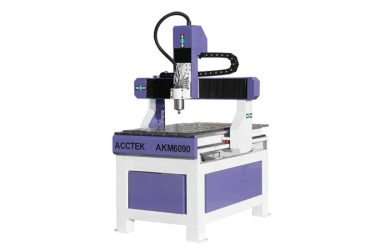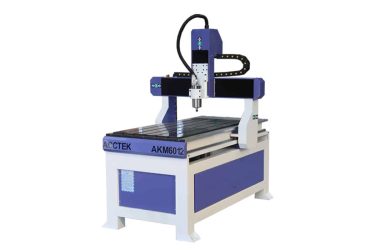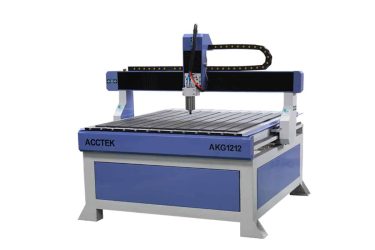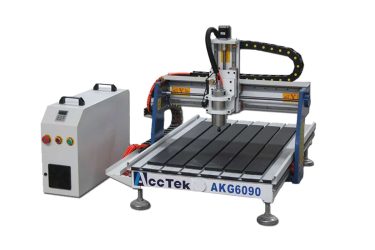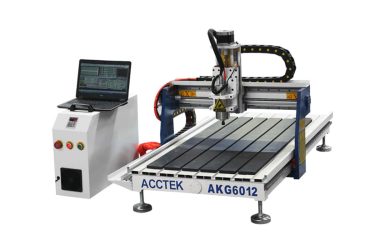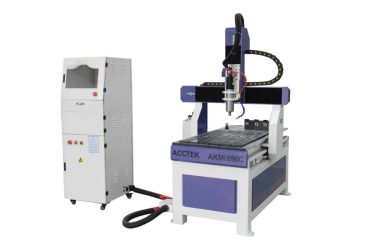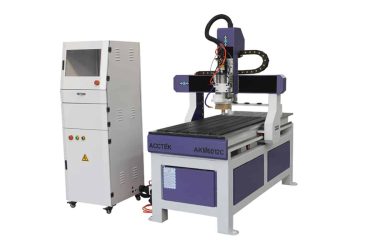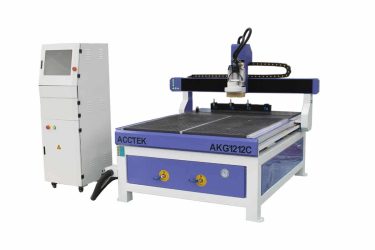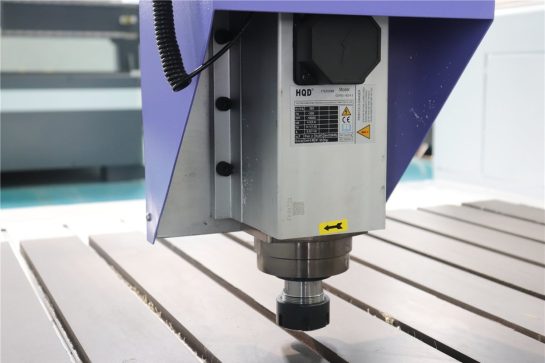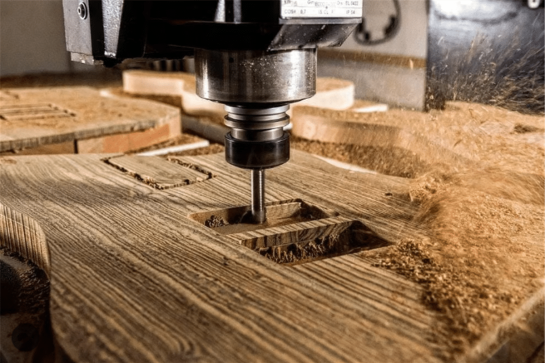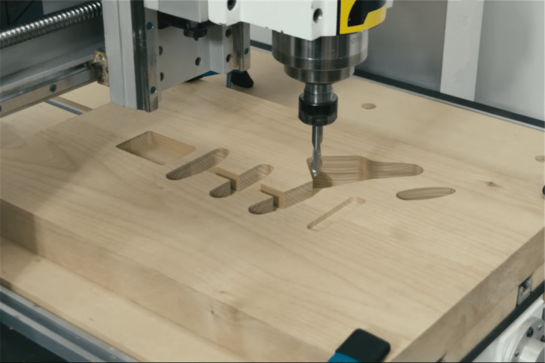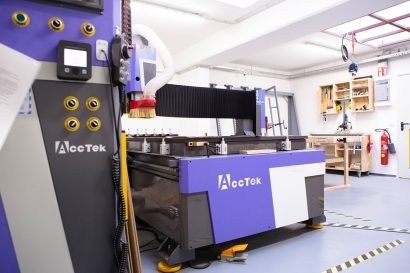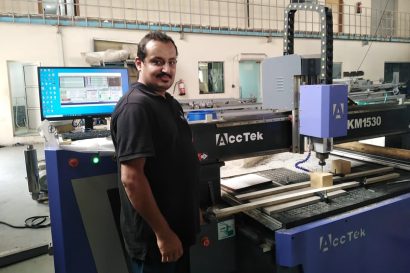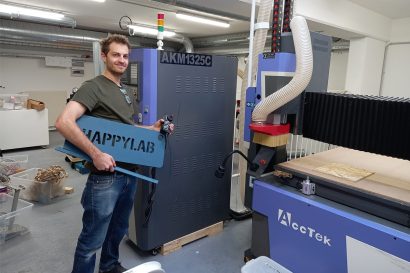Small CNC Router
The small CNC router is a versatile, compact machining tool designed for precision cutting, engraving, and engraving tasks. These CNC routers are commonly used in woodworking, plastic manufacturing, and soft metal processing, making them ideal for hobbyists, small businesses, or educational purposes. It has a compact footprint and can easily fit into limited work environments.
The small CNC router is equipped with computer control systems that can execute precise and complex designs on a variety of materials according to programmed instructions. Users can easily create custom prototypes, intricate patterns, or detailed engravings. Despite their smaller size, these CNC routers typically feature high-speed spindles, precise motion control systems, and user-friendly software interfaces. This makes them accessible to individuals with varying levels of CNC machining expertise, promoting creativity and innovation in small-scale manufacturing and craftsmanship.
Tips for Choosing a Suitable Small CNC Router
Exploring the world of CNC routers can be overwhelming, especially when looking for the best product for your project. We provide concise, practical guidance that details key considerations such as workspace size, material compatibility, and software integration. Whether you’re an experienced craftsman or a DIY enthusiast, we’ll provide insights to help you make informed decisions and unlock the full potential of your small CNC router in your shop.
Workspace size
Measure your available workspace and consider not only the physical dimensions of the CNC router, but also the space required for material loading, tool changing, and operator movement. Make sure there is enough space for comfortable and safe operation.
Material compatibility
Clearly define the materials you plan to use, such as wood, plastic, or metal. Check the CNC router’s specifications to make sure it is compatible with the material you choose. Please note the recommended spindle power and cutting speed for each material type to ensure optimal performance.
Spindle power and speed
Evaluate the spindle power and speed options offered by different CNC routers. Match these specifications to the requirements of your intended application. Higher spindle power helps cut dense or hard materials, while variable speed settings provide flexibility for different tasks.
Accuracy and precision
Study the precision capabilities of CNC routers. Look for features that help improve accuracy, such as ball screws and linear guides. Double-check specifications for positioning accuracy and repeatability to ensure the machine can consistently reproduce the intricate details in your design.
Easy to use
Evaluate the CNC router’s user interface and control system. Consider your skill level and look for intuitive software. Features such as tool path simulation, automatic tool changes and a simple calibration process help improve ease of use and promote a smoother workflow.
Software compatibility
Study the compatibility of CNC routers and CAD/CAM software. Determine whether the machine uses proprietary software or supports third-party applications. Make sure the software matches your design preferences and provides the features you need to create complex tool paths.
Control System
Check the control system of the CNC router. Consider features such as a user-friendly interface, compatibility with industry-standard control systems, and the availability of advanced features like probing or automatic tool calibration. A well-designed control system increases the overall availability of the machine.
Upgradeability
Assess the potential for future upgrades. Check whether the CNC router allows adding accessories, software updates, or component upgrades. Upgradeability ensures your machine can grow with your changing needs and technological advances without the need for a complete replacement.
Support and maintenance
Evaluate the level of customer support provided by the manufacturer. Check out comprehensive documentation, online resources, and responsive technical support channels. Learn about CNC router maintenance requirements, including lubrication schedules and recommended preventive measures to ensure optimal performance and service life.
Build quality and durability
Carefully examine the construction of the CNC router. Assess the quality of materials used, and inspect frames, gantry, and components. Sturdy construction and durable linear guides help improve stability during operation and ensure the machine can withstand the rigors of daily use.
Budget considerations
Define the budget based on the features and functionality required for the project. Consider not only the initial purchase cost but also long-term expenses such as maintenance and potential upgrades. Balance budget constraints with the features needed to meet project requirements.
Comments and suggestions
Seek user reviews and recommendations from individuals or businesses with similar CNC routing needs. Real-world experience can provide valuable insights into machine performance, reliability, and any challenges users may encounter. Consider the manufacturer’s reputation and the machine’s track record in the industry.
What materials can a Small CNC router cut?
The small CNC router is versatile and capable of cutting a variety of materials. The specific materials it can handle may vary depending on the machine’s specifications, particularly spindle power, cutting speed, and rigidity. However, common materials that small CNC routers can typically cut include:
Wood
- Pine
- Oak
- Maple
- Plywood
- MDF
- Cedar
- Teak
Plastics
- Acrylic
- PVC
- HDPE
- LDPE
- Polycarbonate
- PET
- PU
Metal
- Stainless Steel
- Carbon Steel
- Aluminum
- Brass
- Copper
- Titanium
- Gold
Others
- Rubber
- Carbon Fiber
- Laminates
- Leather
- Glass
- Stone
- Ceramics
Application Industry

Construction Industry
The integration of CNC routers into construction workflows has ushered in a new era characterized by meticulous detailing, rapid prototyping, and improved material utilization.

Aerospace Industry
The CNC router is widely used in aerospace engineering due to its unparalleled ability to carve complex designs, manufacture complex parts, and ensure tight tolerances.

Jewelry Industry
The CNC router revolutionize the way fine jewelry is designed and made by delivering unparalleled precision and efficiency and producing intricate designs with meticulous attention to detail.

Stone Carving Industry
The integration of CNC routers into the stone carving industry is not only revolutionizing the way craftsmen carve, it is also redefining the boundaries of artistic possibilities in this ancient practice.
Blog
The Impact of Spindle Power on CNC Router Functionality
This article will delve into how spindle power affects the overall functionality of CNC routers, helping users make informed decisions based on their specific production needs.
Read More
How to Evaluate Energy Consumption and Operating Costs of CNC Router?
This article will guide you through the elements to consider when evaluating the energy consumption and operating costs of a CNC router, providing you with strategies to reduce operating costs.
Read More
How do I Choose The Right CNC Router Size and Capacity for a Specific Need?
In this article, we’ll walk you through the key considerations when determining the proper size and capacity of a CNC router, aiming to help you make an informed decision that ...
Read More
How to Choose the Perfect Woodworking CNC Router Bit
In this article, we’ll walk you through the essential factors to consider when choosing the perfect woodworking CNC router bit. We aim to help you choose the best router bit ...
Read More
Building Musical Instrument with CNC Router: A Comprehensive Guide
This article explores the role of CNC routers in musical instrument manufacturing, providing you with the basic knowledge and guidance you need to use a CNC router to manufacture musical ...
Read More
What Should I Know Before Buying a CNC Router?
This article discusses the things you need to know before buying a CNC router from multiple aspects, aiming to help you choose a machine that can improve your productivity and ...
Read More
Frequently Asked Questions
What is a small CNC router?
The small CNC router is a compact computer numerical control (CNC) machine designed for precision cutting, engraving, and carving tasks. Unlike large industrial CNC routers, small CNC routers are generally more portable and suitable for use in small workshops, DIY environments, or hobbyists. These machines utilize computer control systems to execute programmed instructions and move cutting tools with high precision on a variety of materials.
The small CNC router consists of a sturdy frame, worktable, spindle (cutting tool), and control system. It is versatile and can handle a wide range of materials such as wood, plastics, soft metals, and composites. Users can use computer-aided design (CAD) or computer-aided manufacturing (CAM) software to create complex designs, which are then converted into machine-readable code that the CNC router can follow.
The small CNC router is ideal for woodworking, sign production, prototyping, and other tasks that require material removal accuracy and repeatability. Its smaller size makes it suitable for individuals or businesses with limited workspace and varying CNC experience levels.
How much is a small CNC router?
Small CNC machines in the price range of $3000 to $8000 offer a diverse selection for various applications. Entry-level models, typically priced around $3000 to $5000, cater to hobbyists with smaller work areas and moderate spindle power. Mid-range options, spanning $5000 to $7000, provide enhanced precision and expanded capabilities, making them suitable for a broader range of materials. High-end machines, priced at $7000 and above, feature larger work areas, higher spindle power, and advanced functionalities like automatic tool changers. The actual cost may vary based on brand, specifications, and additional features, and it’s essential to consider software and accessory expenses alongside the machine cost.
Can you make money with a small CNC router?
Yes, you can make money using a small CNC router as these machines offer tons of opportunities in various industries. Here are some ways to generate income with a small CNC router:
- Custom Woodworking: Make custom furniture, cabinets, and wood crafts for sale.
- Signage Production: Create custom signs, plaques, and lettering for businesses or individuals.
- Prototyping: Prototyping services for inventors, designers, or entrepreneurs looking to bring their ideas to life.
- Engraving Services: Provide engraving services for personalized items such as gifts, prizes, promotional products, etc.
- Art And Decoration: Create unique art, decorations, or sculptures for sale.
- Jewelry Design: Designing and manufacturing custom jewelry pieces.
- Small-Scale Production: Small batch production of products such as phone stands, accessories, or specialty parts.
- Educational Seminars: CNC machining seminars or training courses for beginners.
- Online Sales: Sell CNC-produced products on online platforms or through your website.
- Custom Merchandise: Work with businesses or individuals to create custom-branded merchandise.
Do I need a computer for a small CNC router?
Yes, a computer is typically required to operate a small CNC router. The computer serves as the control center for the CNC machine, allowing you to design your projects, convert designs into machine-readable code, and send commands to the CNC router. Here’s how the computer is involved in the process:
- Designing: You use computer-aided design (CAD) software to create the digital representation of the part or object you want to produce. This software helps you design the geometry, specify dimensions, and define any intricate details.
- CAM Software: After designing your project, you use computer-aided manufacturing (CAM) software to generate toolpaths. CAM software translates your design into a series of instructions that the CNC machine can understand. It determines the tool movements, speeds, and depths of cuts.
- Machine Control: The generated tool paths are transferred to the CNC router’s control system via a USB connection, Ethernet, or other communication methods. The control system interprets these instructions and directs the movement of the machine’s motors, controlling the cutting tool’s position and depth.
- Running The CNC Router: Use the computer to initiate and control the CNC router. The computer sends instructions to the machine, specifying the toolpath, cutting speeds, and other parameters.
- Real-Time Monitoring: During the cutting or engraving process, the computer is often used for real-time monitoring. Some CNC systems provide visualizations or simulations of the tool’s movements, allowing you to ensure that the operation is proceeding as intended.
- File StorageAnd Transfer: The computer is also used for storing design files, managing projects, and transferring files between the computer and the CNC router. This is crucial for organizing your work and efficiently running multiple projects.
- Simulation And Testing: Some software allows you to simulate the machining process on the computer before actually running it on the CNC router. This helps in identifying and correcting potential issues.
How hard is it to learn a small CNC router?
The difficulty of learning to operate a small CNC router may vary depending on factors such as your previous experience, technical background, and the complexity of the tasks you want to perform. Here are some things to note:
- Basic Understanding: Learning the basics of a small CNC router, including its components, safety procedures, and how to set up a job, can be relatively simple. Many machines come with user-friendly interfaces and documentation.
- CAD/CAM Software: The complexity of CAD (computer-aided design) and CAM (computer-aided manufacturing) software used to design projects and generate tool paths can impact the learning curve. However, there are some user-friendly software options available, and many manufacturers provide tutorials.
- Programming: For more advanced tasks, such as creating custom tool paths or manually modifying G-code, a deeper understanding of CNC programming may be required. This can be more challenging for beginners with no programming experience.
- Materials And Tool Knowledge: Requires understanding the properties of the materials you will be working with and selecting the appropriate cutting tools for different tasks. This knowledge can be gained over time through experience and experimentation.
- Troubleshooting: Learning to solve common problems, such as a broken tool or misaligned materials, is part of the learning process. Manufacturers often offer support, and online communities can be a valuable resource for troubleshooting.
- Continuous Learning: CNC machining is a skill that benefits from continuous learning. As you gain experience, you can explore the CNC router’s more advanced features and refine your techniques for specific applications.
- Training Resources: Many manufacturers provide training resources, including manuals, video tutorials, and customer support. Taking advantage of these resources can significantly simplify the learning process.

